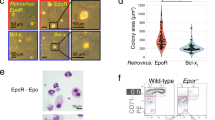Abstract
ANAEMIA is a frequent complication of thyroid dysfunction in man, and often remains unexplained, responding only to thyroid hormone replacement therapy1,2. Thyroid hormone has recently been shown to influence the rate of red blood cell and haemoglobin production3–7. In addition to stimulating erythropoietin (Ep) production3, thyroid hormone has been reported to act directly on haematopoietic precursors4,5. The enhancement of murine and canine in vitro erythroid colony growth by thyroid hormone6,7 suggests that this hormone may have a direct role in the modulation of erythroid proliferation. Studies of murine erythropoiesis support the existence of two distinct, age-structured, Ep responsive populations of committed erythroid precursor cells: the early committed erythroid burst forming unit (BFU-E) and the late committed erythroid colony forming unit (CFU-E)8. These populations are distinguished by cell volume, responsiveness to Ep, and proliferative capacity. The BFU-E, a cell which arises from the pluripotent stem cell soon after its commitment to the erythroid line and which has a high Ep-responsive proliferative capacity, seems to be the precursor of the CFU-E, a cell of lower proliferative capacity. Thyroid hormone has been shown to enhance in vitro erythroid colony formation by canine marrow cells, an effect that may be mediated by a receptor with β2-adrenergic properties7. Velocity sedimentation analysis revealed that colony-forming cells stimulated by this hormone sedimented more slowly than colony-forming cells responding to Ep alone7. Here, we have extended these studies to human marrow cells and have shown that the ability of thyroid hormone to stimulate the erythroid committed progenitor cell does not seem to be a function of the state of differentiation of this cell. Both CFU-E-derived and BFU-E-derived colony formation were enhanced by the hormone.
Similar content being viewed by others
References
Tudhope, G. R. Clin. Haematol. 1, 475–506 (1972).
Horton, L., Coburn, R. J., England, J. M. & Himsworth, R. L. Q. Jl Med. 45, 101–124 (1976).
Peschle, C. et al. Endocrinology 89, 609–612 (1971).
Malgor, L. A. et al. Blood 45, 671–679 (1975).
Fuhr, J. E., Gengozian, N. & Overton, M. Blood 49, 407–413 (1977).
Golde, D. W., Bersch, N., Chopia, I. J. & Cline, M. J. Clin. Res. 24, 309A (1976).
Popovic, W. J., Brown, J. E., Adamson, J. W. J. clin. Invest. 60, 907–913 (1977).
Heath, D. S., Axelrad, A. A., McLeod, D. L. & Shreeve, M. D. Blood 47, 777–792 (1976).
Tepperman, A. D., Curtis, J. E. & McCulloch, E. A. Blood 44, 659–669 (1974).
Gregory, C. J. & Eaves, A. C. Blood 49, 855–864 (1977).
Goldwasser, E. Fedn Proc. 34, 2285–2292 (1976).
Brown, J. E. & Adamson, J. W. J. clin. Invest. 60, 70–77 (1977).
Tsia, J. A. & Chen, A. Clin. Res. 25, 303A (1977).
Ciaraldi, T. & Marinetti, G. V. Biochem. biophys. Res. Commun. 74, 984–991 (1977).
Author information
Authors and Affiliations
Rights and permissions
About this article
Cite this article
DAINIAK, N., HOFFMAN, R., MAFFEI, L. et al. Potentiation of human erythropoiesis in vitro by thyroid hormone. Nature 272, 260–262 (1978). https://doi.org/10.1038/272260a0
Received:
Accepted:
Issue Date:
DOI: https://doi.org/10.1038/272260a0
- Springer Nature Limited
This article is cited by
-
Efficacy of selenium supplementation for mild-to-moderate Graves’ ophthalmopathy in a selenium-sufficient area (SeGOSS trial): study protocol for a phase III, multicenter, open-label, randomized, controlled intervention trial
Trials (2023)
-
Hypopituitarism and anemia: Effect of replacement therapy with hydrocortisone and/or levothyroxine
Journal of Endocrinological Investigation (2005)
-
The v-erbA oncogene blocks expression of α2/β1 integrin a normal inhibitor of erythroid progenitor proliferation
Oncogene (2002)
-
Anemia in infants with congenital hypothyroidism diagnosed by neonatal screening
Journal of Endocrinological Investigation (1996)
-
The effect of cold after whole-body irradiation of the mouse
Radiation and Environmental Biophysics (1993)





